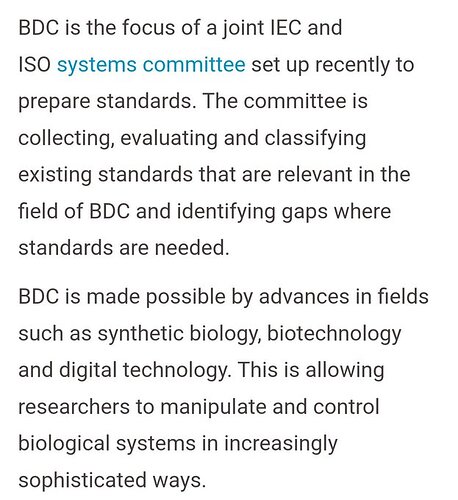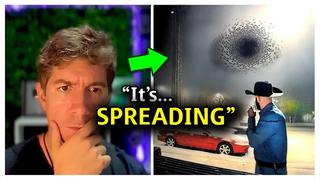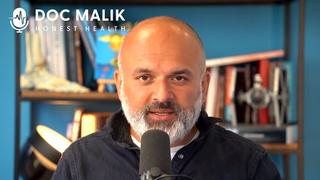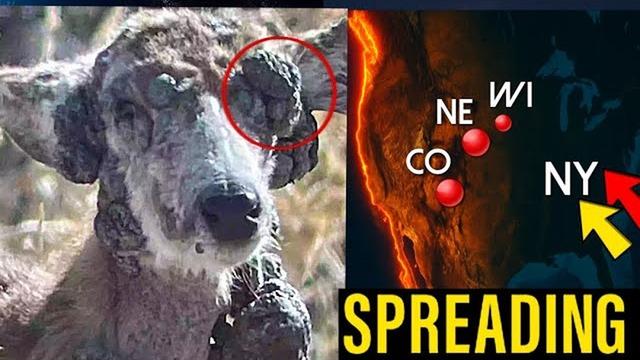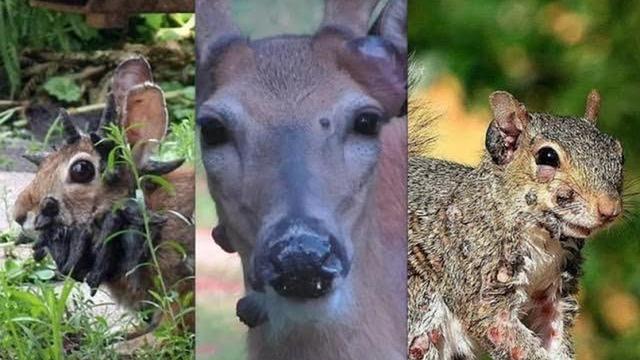The paper it references titled "Evidence of A.I. Assimilation in the Global Population through the Pulsating Current Mechanism" has, I believe, some very deceptive bits and pieces which can convince a vulnerable person to believe they are suffering from this A.I assimilation". For instance the "Sample Experiments" part at the end.
Hi Cybe2,
Here is the link, but not certain if this is the original source:
Agreed. I hope it is not true. But, cannot say for certain that it is not. Over the years, numerous people have talked about voice to brain technology.
Yes. A motive: To deceive the populace into believing THEY possess more technology than they really do. But, what if THEY do?
Can’t find any others. The channel also has an earlier video with the same presenter.
Ironically this channel avatar is AI generated
Standards guiding the bio-digital revolution
https://www.iec.ch/blog/standards-guiding-bio-digital-revolution
One of the newest and most exciting frontiers of engineering is based on the convergence of biology and digital technology. Bio-digital convergence (BDC) has a wide range of possible applications, some of them unexpected.
Take for example first response operations following natural and human-made disasters. Sometimes rescue dogs are unable to move through the debris of collapsed buildings, which is where cyborg cockroaches could one day take over.
There is nothing new about scientists manually mounting microchips and sensors onto cockroaches to control their movement, with DIY kits for building your own roach bots available online. The challenge is that rescue missions would require swarms of cyborg roaches to comb the debris, which is not feasible when each roach-bot takes 30 minutes to make.
That could be about to change. According to the New Scientist, researchers in Singapore have developed a robot arm that makes it possible to mass-produce cyborg cockroaches, from anaesthetizing them to fitting their electronic backpacks.
BDC is the focus of a joint IEC and ISO systems committee set up recently to prepare standards. The committee is collecting, evaluating and classifying existing standards that are relevant in the field of BDC and identifying gaps where standards are needed.
BDC is made possible by advances in fields such as synthetic biology, biotechnology and digital technology. This is allowing researchers to manipulate and control biological systems in increasingly sophisticated ways.
It is a rapidly evolving field that holds great promise for a wide range of applications. By merging biology and digital technology, scientists are creating new tools, technologies and applications that could have a profound impact on many aspects of our lives, from healthcare to agriculture and environmental protection.
It includes the use of digital tools and techniques to design and synthesize new biological components, such as DNA, proteins and cells, as well as the use of digital technology to control and manipulate these biological systems in real time.
Renewable energy is another field that is likely to benefit. Researchers are using bio-digital technologies to create new types of biofuels, as well as to develop advanced algae-based systems for capturing and storing carbon dioxide. These technologies have the potential to provide clean, sustainable and renewable energy sources that could help to reduce our reliance on fossil fuels.
As the article in the New Scientist illustrates, bio-digital convergence could one day even play a role in pulling survivors from the rubble of collapsed buildings. When that happens, Colin the cockroach could be vying against Roger the rescue dog for media attention.
Researchers have successfully laced dental floss with mRNA components and flu vaccine ingredients
Detailed in a study published in Nature Biomedical Engineering on July 22, 2025, “needle-free innovation” involves coating dental floss with vaccine components—such as proteins, inactivated viruses, peptides, and mRNA.
Article:
Bill Gates-Funded Scientists Develop mRNA Dental Floss to ‘Vaccinate’ Public Without Injections
In a shocking new development, scientists have unveiled a controversial method for delivering mRNA vaccines using dental floss instead of needles.
Dental floss, of all things, has become the latest delivery system for “vaccines,” bypassing injectables and entering uncharted territory in mRNA technology.
A study published in Nature Biomedical Engineering reveals how researchers have successfully laced dental floss with mRNA components and flu vaccine ingredients.
They then applied it to the gums of mice.
What followed was a remarkably effective immune response that the scientists claim could revolutionize how we administer vaccines in the future.
But as with everything involving mRNA technology, the stakes are high, and so are the questions.
The team of scientists was led by Dr. Rohan S. J. Ingrole of the Department of Chemical Engineering at Texas Tech University.
The university in Lubbock, Texas, is funded by Microsoft co-founder Bill Gates.
This new dental floss “vaccine” method takes advantage of the gingival sulcus, the tiny trench between your gums and teeth.
The researchers believe this delivery method offers a unique, highly permeable entry point into the bloodstream.
The gumline’s permeability could allow for vaccine molecules to be absorbed directly into the body, bypassing the complications of traditional oral methods or the discomfort of injections.
While the concept may seem far-fetched, it’s rooted in research that’s getting increasing attention from the scientific community.
The idea is that by using floss laced with “vaccine” components, medical researchers could provide an alternative to traditional “vaccination” methods, without the need for needles, specialized medical staff, or even consent from the public.
But let’s not get carried away with the idea of “innovative progress” just yet.
As the study itself reveals, the method of applying these vaccines involves an odd procedure.
In the mouse trial, one researcher had to hold the rodent’s mouth open with a keychain ring while another person flossed the animal’s gums with the vaccine-laced thread.
While the method may have been unorthodox, the results were striking: 75% of the protein from the floss was absorbed into the gum tissue.
The researchers stated in their paper that the immune response triggered by the “vaccine” was strong enough to survive a lethal strain of influenza.
However, while mass-vaccination advocates may be hailing this new development as the new “magic bullet” for “vaccines,” the news also raises major concerns.
The research is still in its infancy, and while it may be pitched as an easy fix for needle-phobic individuals, the implications are much more far-reaching.
For one, imagine the potential for this method to be used outside of your control.
If the floss-based “vaccines” become widespread, there’s a real concern about consent, transparency, and safety.
Could this technology be used for mass “vaccination” campaigns without the public being aware that it is being administered?
Given how quickly government entities and corporations have adopted new health policies in the past, this may be a possibility too close for comfort.
It also raises questions of how this technology could be adapted to add mRNA “vaccines” to other basic necessities, such as toothpaste or even drinking water.
The U.S. Centers for Disease Control and Prevention (CDC) and other public health bodies have pushed for easier, more accessible vaccination methods, especially during pandemics or emergencies.
The argument is that floss-based “vaccines” could be delivered by mail, making them accessible to people anywhere without the need for a doctor or health professional to administer the shot.
This could be convenient for mass vaccination campaigns, but it opens up a massive door for coercion, whether overt or subtle.
Imagine receiving a package in the mail with instructions to simply floss your teeth to “protect yourself” from the latest health crisis.
Sounds harmless enough, until you consider the implications of who’s making those decisions and how much oversight you’d really have over what’s going into your body.
What’s more, the use of mRNA technology for this delivery method comes with its own set of concerns.
We’ve already seen the risks associated with Covid mRNA “vaccines,” and the long-term effects remain uncertain and far from positive.
Adding another layer of delivery via an everyday product like floss doesn’t exactly inspire confidence, especially considering how little we know about the full consequences of mass exposure to synthetic mRNA.
The researchers in this study argue that the method could be a game-changer for people with a fear of needles and in resource-limited areas where traditional “vaccine” administration might be challenging.
But the truth is that this is yet another step into uncharted territory, where science is rapidly evolving but leaving important ethical and safety considerations in its wake.
As one study participant expressed, people may prefer flossing over getting a needle.
However, we must ask ourselves whether the convenience is really worth compromising the safety and integrity of our health decisions.
The new era of “painless” vaccine delivery could be an alarming path to a future where consent is an afterthought, and personal autonomy over our health choices is further eroded.
For now, it’s up to us to question: Who controls what’s in our bodies, and how far are we willing to let them go in the name of convenience or public health?
When Bill Gates is the man funding these developments, these questions must be addressed.
Stay vigilant, stay informed, and keep questioning what’s really being done in the name of “progress.” Bill Gates-Funded Scientists Develop mRNA Dental Floss to 'Vaccinate' Public Without Injections - Slay News
Animals Mutating — Something’s Going On
A wave of strange mutations is being reported across America’s wildlife — from rabbits growing horn-like tumors to deer covered in unexplained growths. Scientists are linking many of these cases spread by ticks and mosquitoes, raising new concerns about what could be unfolding in nature. Recent photos and field reports show horned “jackalope-like” rabbits in Colorado, Minnesota, and Nebraska, along with deer suffering from massive fibromas. At the same time, federal agencies are fast-tracking animal drug approvals, opening new tick-borne disease centers, and warning about rare parasites re-emerging in the United States. While many of these events are said to be isolated, the clustering of outbreaks and official responses suggest something larger may be happening beneath the surface. - JWTV.
Article: Freaky photos of ‘black-bubbled’ deer go viral after fears of zombie rabbits, squirrels spread Freaky photos of 'black-bubbled' deer go viral after fears of zombie rabbits, squirrels spread | New York Post
